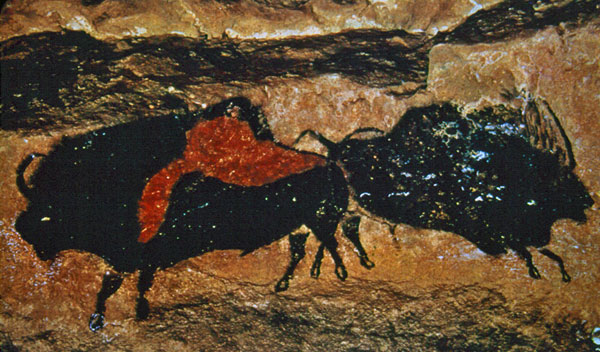
BACKGROUNDTaxonomy is the system by which all living organisms are grouped and classified hierarchically on the basis of their similarities and differences. It was devised by the Swedish physician, botanist and zoologist Carl Linnaeus, who published the last and definitive version of his Systema Naturae in 1758. The terminology is almost entirely Latin or Greek, and was based on the species (Latin: ‘type’), which described a self-reproducing group whose offspring are fertile. Related species are grouped into a genus (Latin: ‘clan’) whose members can claim descent from a common ancestor. An individual organism is classified by its Genus + species, normally written in italics— so a red maple is known as Acer rubrum and modern humans are known as Homo sapiens. The various genera were grouped into Families, the families into Orders, the orders into Classes and the classes into Kingdoms. Each of these groupings is known as a taxon (plural: taxa). Linnaeus had no idea of the vast length of the time period involved and, in any case, he was not particularly interested in evolutionary development. Like most of his contemporaries he believed that the universe was divinely ordained and only wanted to give it some sort of organization but, barely half a century after his death, geologists had begun to appreciate the extreme age of the planet. By observing the rate at which geological formation takes place today they realized that it would have taken millions of years at least and that the sequence could be recognized in the layering of the rocky deposits they were studying. They also noticed the fossilized remains of early life forms among them and realized that they were clearly quite ancient. To cope with all of this new information, Linnaeus’ original rankings were expanded to eventually include such things as the Domain, the Phylum, and the Tribe—and some were subdivided to include categories such as Sub-order, Infraorder and Parvorder. One hundred years after the appearance of Systema Naturae Charles Darwin published On the Origin of Species in 1859. His theory of ‘natural selection’ provided a mechanism by which change took place as Life evolves. It proposed that, within a species some individuals developed attributes—deeper roots, longer Not long after The Origin of Species was published, an Austrian monk named Gregor Mendel conducted a series of experiments with peas that introduced the idea of genetic mutation into the equation. Although he gave up his scientific work when he became abbot of his monastery in 1868, it led to the discovery of ‘genes’ and eventually of DNA. These represent the information passed down from generation to generation and determined the characteristics that made an individual a member of a species. The similarities and differences in the organization of this information determined the relationship of the species to other contemporary species and to ones that had gone before. It was copying errors that led to mutations (favourable or not) in the individual animals. The division of one species (cladogenesis) into two takes place when one group is reproductively isolated from the rest and ends when interbreeding between them is no longer possible. The new line continues until another split occurs or the species becomes extinct. The process cannot be observed and it is rarely evident in the fossil record which is full of gaps, both chronological and geographical. In any case, it is most often the The notion of a Tree of Life is an ancient one and very widespread, appearing in just about every human culture and religion. It expresses the idea of a universal hierarchy of life, with large branches growing outwards, dividing and sub-dividing ad infinitum. Nowadays the concept is known as phylogeny and is often expressed using cladograms, such as the one shown (right), which depicts the ‘links’ in the chain of primate and human evolution. The black dots (‘nodes’) in the diagram represent common ancestors shared by two or more branches in the tree. The more recent the node and the fewer the number of intermediary nodes, the closer the relationship. Otherwise there is no time dimension in a cladogram. Constructing a cladogram is a very complicated business, given that each and every branch is capable of doubling which could lead to an almost incomprehensible number of variations. Fortunately the numbers can be thinned out through observation of the structure of living and fossil specimens but not entirely. Observed differences are very subjective and there has been and still is plenty of dispute over their nature, sequence and importance. These days, molecular-clock analysis is used to estimate the time when two taxonomic ranks separated, based on the degree of similarity in their genetic makeup and biochemistry. GEOLOGICAL TIME SCALEGeological time scales are based on rock formation and the dating of each layer through what is known as ‘geochronology’. The largest unit of time is the Eon, which encompasses hundreds of millions of years. It is subdivided into Eras (tens of millions of years); Periods (millions of years); Epochs (hundreds of thousands of years); Subepochs (tens of thousands of years) and Ages (thousands of years). LIFE BEGINS
One of the nucleic acids that emerged from all of this chemistry was DNA (deoxyribonucleic acid) which carries the hereditary information The earliest organisms, it would appear, were entirely dependent on the ‘soup’ that made up their immediate environment. Moving away from it was only possible if they could enclose that mixture in some sort of envelope and take it with them. The result was a strand of nucleic acid together with some proteins and other chemicals enclosed by a fatty membrane—a cell. Although these forms may have appeared much earlier, the oldest indisputable fossils date to about 2.8 billion years ago. They represent the remains of “microbial mats” known as stromatolites which were apparently able to generate energy directly from the sun through a form of photosynthesis, giving off oxygen as a by-product. The most successful of the stromatolites were the Cyanobacteria (right) who emitted so much oxygen that it entirely transformed the earth’s atmosphere and led to the extinction of almost all of the original, anaerobic, forms of life. This is known as the “Great Oxidation Event”. The few that have survived to the present are found deep in the ground or in the lungs and guts of humans and other animals.
DESCRIPTION
Proteins within the nucleus combined with DNA to form chromosomes, which carry the genetic information necessary for reproduction. Also present is the nucleolus which is a centre for the production of ribosomes which, in turn, are used to manufacture proteins. The incorporated bacteria found outside the nucleus are known as organelles, each with its own specialized function. Chloroplasts developed from cyanobacteria and are responsible for photosynthesis in plant cells; mitochondria looked after aerobic respiration, creating energy by oxidizing glucose into CO2 and water; while centrioles play an important role in cell division. Mitochondria are enclosed within their own membranous envelope and reproduce separately from the rest of the cell. They also have their own DNA—something that has played an important role in our understanding of human evolution. The oldest certain fossil evidence of eukaryotic cells have been found in northern China and date to about 1.8 billion BP.
DESCRIPTIONThe number of kingdoms has increased from three to five since Linnaeus’ day. Mineral, has been dropped while Bacteria, Fungi and Protista (amoeba-like creatures) have been added. The other two, Plantae and Animalia, are both Eukaryotes but can be distinguished on the basis of the means by which they obtained energy (nourishment). Plants do it through the photosynthesis of sunlight and the absorption of minerals from the earth. Animals do it Nearly all animals reproduce sexually, a process that involves the fusion of two cells, an ova and a spermatozoa, which normally come from different parents (a male and a female). Each of them contains the genetic information (genome) needed to create a new member of the species. Because two parents and four grandparents are involved in the process there is a greater chance for mutation to take place. A favourable mutation would be one that increases the likelihood of an individual to survive and pass the benefits on to its descendants. Once fertilized, the original cell multiplies through a process known as mitosis whereby the cell divides and creates a clone of itself. These clones contain genetic information which enables them to reconfigure and reposition themselves to form different types of cell that perform a wide range of functions, some of them very complex such as those belonging to the internal organs. Initially, these organisms were very simple, but their unique features gave them the potential to create a bewildering variety of life forms. They were entirely made up of soft tissue and therefore left little trace in the fossil record. What appear to be the earliest were found in what is now South Australia, in the Ediacaran Hills. The fossils have been dated to about 665 million years ago, a time when the earth was going through its most severe series of ice ages ever—the Cryogenian Period (c. 720-635 million BP). Some believe that the entire planet was covered in ice and have dubbed this period “Snowball Earth”. Somehow, life managed to survive in the depths of the ocean. Palaeozoic Era
DESCRIPTION
All chordates, at some stage in their development, possess what is known as a notochord. This is a semi-flexible rod that runs the length of the body to provide structural support and give the organism bilateral symmetry (each side is mirror image of the other). They also had a distinct head and tail, which meant the animal had a particular orientation and sense of direction. The head was where most of the sensory equipment was located, be they eyes, feelers or whatever, and was the centre for information processing centre. Some developed jaw-like features that enabled them to seize their prey. Their movement controlled by the nerves within the notochord enabling them to wriggle and propel themselves in much the same manner as fishes do today. Finally, chordates have gill slits along their throats through which they filter nutrients out of sea water. All chordates, including us, share these features, even if they are only present in the embryonic stage. Although they have no hard parts, their fossils are preserved in lower Cambrian rock strata found in southern China, the Maotianshan Shales in Yunnan province, which have been dated to 525-520 million BP.
DESCRIPTIONDuring the following Ordovician Period (c. 485-444 million BP) a Subphylum known as the Vertebrata emerged from the Chordata. They were more advanced creatures with an internal skeleton, a well-defined head with a set of eyes, a tail, and (most importantly) a brain. The skeleton was made of cartilage and bone, and included a skull to enclose the brain along with a primitive The Carboniferous Period (c. 359-299 million BP) saw much of the planet covered by vast forests. The name derives from the Latin word for “coal-bearing” and it was at the end of this period that the rich coal The first of these were the amphibians whose limbs were jointed in the middle so that the upper part of the leg (the thigh) stuck out sideways from the body to the knee where the lower part with the foot dropped down to the ground. They developed shoulder blades and hip bones to attach the heavier muscles they needed to counter gravity. In fact, the array of bones that make up the limbs of modern humans, especially of the wrist and ankle, and the hand and foot, were formed at this stage. However, although amphibians could operate on land, they spent much of their lives in the water and had to return there to breed The example shown (right) belongs to the genus Batropetes and dates to the Permian Period (c. 299-252 million BP).
Beginning in the Carboniferous and continuing until the Triassic, the scattered continental plates began to reassemble to form a new supercontinent, centred on the It would be especially helpful for their survival if their eggs did not have to be formed, fertilized and hatched in the water and that the whole process could take place on dry land. The solution was the evolution of a tough, protective envelope that contained all of the There were two main lines of descent that emerged from the Amniotes, each distinguished by their skull structure. The first was the Sauropsids, which includes the dinosaurs together with all later reptiles and birds, and the Synapsida, which include the mammals as well as other, closely related species. At this point, there was little to set them apart from the reptiles apart from the fact that they had one rather than two openings (temporal fenestrae) in the side of their skulls, behind each eye socket. The success of both groups was mainly down to the fact that they had developed thick, leathery, less permeable skins that allowed them to retain moisture in a hostile environment. Mesozoic Era
DESCRIPTIONThe Palaeozoic ended in a global catastrophe known as the Permian-Triassic Extinction Event, also known as the ‘Great Dying’, when some 57% of all biological families along with 83% of all genera disappeared from the fossil record—the synapsids were practically wiped out. The cause is unclear but a possible candidate may have been the release of greenhouse gases from massive volcanic eruptions that took place in Siberia, which would have led to a dramatic increase in temperature throughout the The class known as Mammalia gets its name from the fact that all of them feed their young by providing them with milk which they secrete through mammary glands (Latin mamma, “breasts”). The species that emerged in the late Triassic were all tiny, weighing as little as 2.5 grams, but they had a number of features that distinguished them the rest of the amniotes. Their bodies were covered with fur or hair rather than leathery scales. Because they were high energy users, they had four- rather than three-chambered hearts and breathed through a set of lungs powered by a diaphragm. They were able to store energy within their bodies in the form of fat and maintained a constant, relatively high body temperature, which meant that they were capable of operating effectively at night. However, this came at the price of having to continually take on fuel—going without food for more than a few hours meant death by starvation for these tiny creatures. Although no larger than a shrew, these early mammals were adept hunters, seeking out and devouring insects and worms among the roots and leaf litter of the forest floor. To this end, they developed more efficient and specialized teeth—incisors (for gnawing and holding), canines (for stabbing), premolars (for puncturing) and molars (for grinding and chewing). The outer ear in most mammals was mobile and could be used as a direction finder to detect faint movements among the twigs and leaf litter. The structure of their eyes was fairly simple compared to most reptiles who have full colour vision, and can adjust the shape of their lenses to focus on objects at different distances. To compensate for this, they developed a set of mucous covered bony scrolls in their noses which gave them an acute sense of smell. Changes in the shape and positioning of their vertebrae, and in the placement of their limbs, which were now suspended vertically from the torso, gave them a more erect posture and a more efficient gait. With a more flexible back and propelled by strong hind legs mammals are able to cover ground much faster. The earliest mammals laid eggs with shells and some of their descendants (such as the platypus) still do so, but this was a poor proposition in anything less than ideal. watery conditions. The investment of energy needed to provide an egg with the means to enable the foetus to survive was substantial and tiny mammals simply did not have the At around the middle of the Triassic the supercontinent of Pangaea (left) began to break up and separated into two major landmasses—Laurasia, made up of what is now North America and all of Eurasia except India; and Gondwanaland, which included Africa, India, South America, Australia and Antarctica. Very slowly, at a rate that amounted to millimetres per year, these bits and pieces moved towards their present positions. The Mesozoic era ended as it began—with an environmental catastrophe. This time it was the result of a collision about 66 million years ago with a large asteroid, one that created an enormous crater just off the north coast of the Yucatan Peninsula in Mexico. The Chicxulub crater is 180 kilometres in diameter and 20 kilometres deep and the impact threw up a cloud of dust that blocked out the sun all over the globe for years, preventing photosynthesis and plant growth. This led to what has been called the Cretaceous/Palaeogene Mass Extinction when about 75% of all plant and animal species disappeared from the fossil record at this time—most notably, all of the non-avian dinosaurs. After some 150 million years or more, their dominance came to an end. cenozoic Era
DESCRIPTIONAlthough catastrophic for the dinosaurs, the long term effects of the asteroid strike were negligible as far as the climate was concerned. Once the dust settled at the start of the Palaeocene epoch, conditions returned to pretty much what they had been before. For most of the planet that meant a warm, moist climate—either tropical or subtropical—and, although it was cooler and more temperate towards the poles, there were no icecaps. The average global temperature was somewhere around 25°C, or about 10° warmer than today while carbon dioxide levels were much higher.
Like most other mammals, the first primates were quadrupeds and moved about the branches by leaping and galloping much like today’s squirrels. To that end, there were a number of morphological changes to their bodies that became much amplified with time. Other mammals have well-padded feet or hooves to help them run or claws used for digging and clutching onto prey but primates were developing hands and feet that could be used for grasping and climbing. They had a strong, opposable big toe (hallux) and pliable, more sensitive pads on their fingers, covered with lines and ridges to give a surer grip. They also had flattened ‘nails’ rather than claws on their toes and fingers. The fruit and flowers are found at the tips of the lightest branches and the more equipped an animal was for hanging on and reaching out, the better. The sensory equipment of primates is different than that of other mammals. There is much less emphasis on a sense of smell and much more on vision and hearing. The part of the brains that deals with sight is much larger and more complex. The structure and position of the eye sockets (orbits) indicates that they had binocular vision and were better able to judge Fossil evidence for the earliest primates, the so-called ‘euprimates’, consists of two partial skeletons found in the lowest level of Eocene deposits in central China (Hubei Province), Teilhardina asiatica and Archicebus achilles. They were both tiny but with sharp teeth and forward looking eyes. They had sharp-cusped molars which worked like pinking shears, ideal for crunching bugs. This would change as the primates diversified. Fossil evidence is limited to little more than a few teeth until the beginning of the Eocene epoch (c. 56-34 million BP) when more complete skeletons turn up at a number of places in various parts of the northern hemisphere—in China, India, Europe and North America. The earliest remains discovered so far come from a pair of partial skeletons found in Hubei Province, China— Teilhardina asiatica and Archicebus achilles—which have been dated to about 55 million years ago. They were tiny animals weighing no more than 30 grams very similar in appearance to a mouse lemur. Their back teeth have high, sharp cusps—well-designed for crunching insects—and they had relatively large, forward facing eye sockets, suggesting they were most active during the day.
Cenozoic Era
DESCRIPTIONThe Primates branched into two principal Sub-Orders, the Haplorhini (also known as the Anthropoidea), which includes all of the monkeys, apes and the tarsiers; and the Strepsirrhini, modern lemurs and lorises.
Much of the fossil evidence for early haplorhines comes from the Fayyüm Depression in the Western Desert of Egypt which has proved to be a mother lode. No less than 18 different species belonging to four different families of extinct anthropoids have been identified. The skulls are all characterized by smaller braincases than comparably sized monkeys of today. Each family retain a number of primitive features and incorporates a few new ones, which have to do with their dentition, the structure of their eye sockets and of the ear region. None of them have the complete set of changes, however, so there is no clear evolutionary pathway leading to us. These developments were played out against a background of continuous tectonic movements that had an enormous impact on the environment. Old landmasses were breaking up and the pieces were drifting into new configurations. Australia spit from Antarctica, which changed the flow of the ocean currents in the southern hemisphere bringing cold water further north. India slowly drifted into Eurasia to begin a process that led to the formation of the Himalayas, changing rainfall patterns all over a large area of the planet. In East Africa, a pivotal area for human evolution, there was a lot of volcanic activity resulting from the collision of the African, Arabian and Somalian plates. Temperatures dropped steadily during the Eocene. The vast tracts of rainforest that had blanketed the earth at its beginning began to thin out during the later stages, due to the increasingly cooler and dryer conditions, with the tropical and subtropical forests diminishing and being replaced by temperate ones in the higher latitudes. Most species of grass evolved during this period but were largely confined to riverbanks and lake margins.
DESCRIPTION
Identifying the last common ancestor of the simians and the tarsiidae has proved difficult. The earliest fossil remains are scrappy (jaws and some foot bones). They belong to a species known as Eosimias sinensis (right) and were found in Jiangsu province, southern China in deposits dating to about 45 million years ago. It shares dental similarities with both tarsiers and anthropoids. There is evidence of diversification during the Oligocene and similar species have been found elsewhere in Eurasia and in Africa. These are linked mainly on the basis of their dental formulation but otherwise they are little different from earlier haplorhines. The sudden cold snap at the end of the Eocene led to the formation of great ice sheets in Antarctica. This meant that more and more of the earth’s water was locked up and rainfall levels began to drop precipitously all over the planet. Continuous tectonic activity was throwing up new mountain ranges which had an enormous impact on seasonal rainfall patterns. The result was gradual expansion of open areas (savannah) at the expense of the ancient forest. Much of the new space was colonized by the various grasses that now appeared, interspersed with stands of woodland and solitary trees. Since grass required more complex digestive systems to process, it was browsing animals that profited most from the new conditions.
DESCRIPTION
Molecular-clock analysis suggests that the split between the two took place in Eurasia at the very end of the Eocene, some time before 34 million BP. Since this is well after the date of the separation of South America from the Old World, exactly how they managed to get there is a bit of a mystery. Floating rafts of driftwood cast loose during storms bearing pregnant simian females have been suggested, however unlikely that may seem. The fossil record (once again) is very limited and scattered during the Oligocene, and the earliest found so far (dating to about 29 million BP or perhaps a bit later) come from the Fayyüm Depression in Egypt’s Western Desert . Widespread erosion had scoured most of the continent at the end of the Eocene, obliterating virtually all evidence of previous fauna, but fortunately the low-lying Fayyüm was underwater at the time and was largely spared. Among the many Fayyüm remains were those of several Aegyptopithecus zeuxus (left) who some reckon to have been the common ancestor of all later species of ape and a crucial link in our own evolution. There must have been some sort of connection between Asia and Africa at the time although there is no evidence of a land bridge before ca. 23 million BP. Fossil catarrhines have been found at a number of locations across Eurasia, and have been identified primarily on the basis of their dentition. Otherwise their bodies resemble those of quadrupedal monkeys rather than of apes. The skull structure of these early catarrhines shows that, among them, were the ancestors of the orangutans as well as the ‘great apes’ of Africa.
DESCRIPTIONSometime early in the Miocene, the Catarrhines split into two ‘Superfamilies’—the monkeys were grouped as Cercopithecidae, while the apes are now called the Hominoidea. Apes predominantly inhabit the equatorial rainforests and woodlands where the conditions are not conducive to fossil formation and what remains there are widely scattered and very fragmentary. Teeth are most likely to survive so distinctions are most often based upon them, but some of There are certain obvious physical differences between modern monkeys and apes. The latter have no tails but they do have larger skulls and bigger braincases. The structure of their shoulders is different which has to do with their different modes of locomotion. Monkeys remained fully quadrupedal, galloping along the tops of branches and leaping from one to another. Apes moved through the forest by climbing and swinging by their arms from branch to branch, a technique known as brachiation. The long bones of their arms were much straighter and longer than those of monkeys, while their wrist joints were looser. Quadrupeds needed powerful back (epaxial) muscles and a very flexible spine to enable them to stretch out when at the gallop but apes did not, so there were fewer vertebrae in the lower lumber region, making it shorter, and their back muscles were much reduced. This meant that weight was more evenly distributed around the vertical axis of their bodies. Ape faces are flatter than most monkeys and their noses are broader rather than pointed reflecting the pre-eminence of the sense of sight over smell. Their teeth were arranged in a U-shaped dental arcade and included rather large canines designed for puncturing and ripping. These tended to be larger in males who used them in combat with other males for dominance. All of them exhibit sexual Most apes spend the better part of their time on the ground, although they are quite capable of moving about in the trees and many of them nest there overnight. They are also capable of some degree of bipedal locomotion— monkeys can move about on their hind feet but they usually have to be taught. Unlike monkeys who are mainly vegetarian, all of the apes are omnivorous—although different species have their own dietary preferences. Many stick to fruit and leaves while others are able to get by on insect larvae if necessary. The fact that chimpanzees hunt down and kill monkeys and smaller apes such as bonobos is well-documented. When the apes first appeared, the earth’s climate was continuing its prolonged cooler and drier trend. The Antarctic ice cap grew ever larger and glaciers began to spread in the far northern latitudes—in what are now Greenland, Scandinavia, Siberia and North America. The conditions favoured an expansion of temperate forests at the expense of the sub-tropical forests in the north, and of open plains nearer the equator. In Africa, this was exploited by a variety of megafauna, giant-sized ancestors of many of the modern herbivores—rhinos, giraffes, hippos, etc. All of them appear to have been browsers, feeding on leaves; none of them have the dentition typical of grazers who feed on grass.
DESCRIPTIONGibbons (Hylobatidae) share the least amount of DNA and morphology with the other Hominoidea and have therefore been grouped separately from the rest—the chimps, gorillas and orangutans. These are now classified as Hominidae, also known as the ‘Great Apes’. Although many of them continue to nest in the trees for safety, they also spend much of their Fossilized remains dating to the Early Miocene have been found in East Africa along with those of other simians. One such is Ekembo heseloni (formerly known as Proconsul africanus), represented by a number of partial skeletons and the nearly complete skull of an adult female. Their postcranial structure resembled that of monkeys more than apes. They had legs and torsos that were much better suited to quadrupedal locomotion than brachiation but their dentition and facial structure was more apelike (such as Afropithecus turkanensis (left). The Miocene epoch saw enormous changes in the geomorphology of the planet, mainly due to continental drift and volcanic activity, which created whole new mountain ranges. The Indian Plate was pushing steadily against Eurasia, raising the Himalayas and having a huge impact on the annual monsoons. At about the same time, the Arabian Plate collided with Africa and both of them with Eurasia, opening up a land bridge and allowing an exchange of animal species. Many of these were ruminants, attracted by the various grasses that had colonized the open savannah and whose multichambered digestive systems were capable of processing the huge volumes required. In the years between 18 and 4 million BP, these grazers became a major component of the open landscape and early species of cattle, antelope, bison, wildebeest and equid could be found alongside the proto-elephants and giraffes. All of this meat on the hoof attracted the attention of a wide array of big game hunters, mainly felines and canines, and the scavengers that accompanied them. Although these developments were to play a vastly important role in hominin evolution, that time was yet to come.
DESCRIPTION
Evidence of a number of related, contemporary genera have been found spread across southern Eurasia which, up until then, had been separated from Africa. Members of the genus Sivapithecus found at various sites in northern India have similar skulls to orangutans but their body shape is closer to that of monkeys. Europe was still relatively isolated owing to the presence of ancient seas and oceans that effectively cut it off from Africa. Nevertheless, it was in Europe that the remains of primates that are most likely our direct ancestors—the Dryopithecids—have been found. The earliest discovery so far is of a partial skeleton identified as Pieralopithecus catalaunicus, found in Spain and dated to 12½ million BP. It probably weighed about 30 kg, about the same as a Unfortunately, for a variety of reasons—erosion, inaccessibility, political turmoil, etc.—there is not a lot of fossil evidence from central Africa for this period. As far as we know, the apes of the time still lived in the forest, spending most of their time on the ground but were still quite able climbers, moving carefully among the branches. At the very least it offered them a means of escape if threatened on the ground. The open plains (savannahs) continued to expand but, although the rewards were great, it was still a very dangerous territory for them. They weren’t strong enough, nor nimble or quick enough to deal with the large carnivores that prowled the country. The best they could manage as far as locomotion was concerned was the sort of ‘knuckle walking’ that you see today among chimps and gorillas. In order to minimize damage to their long, sensitive fingers, they curled them over and walked on the top sides where the skin was much thicker. However, it is too slow and inefficient to cover any great distance (or even a short one) with any speed.
DESCRIPTION
One candidate for the last common ancestor is Sahelanthropus tchadensis (right), whose fossil remains were discovered in Chad in 2001 and have been dated to the very end of the Miocene (c. 7-6 million BP). In some respects—its relatively small brain (378 cc) and very prominent brow ridges—it was very ape-like, but in other respects it was similar to humans. Its muzzle didn't protrude as much, and its foramen magnum (the opening where the spinal chord passes to connect with the brain) was further forward, suggesting a more upright posture. However, a femur found in association does not appear to be particularly well-adapted for bipedal locomotion. At the end of the Miocene, the world-wide trend to cooler, drier conditions continued, as did the shrinking of the forests and the expansion of the open plains. Game was abundant and so too were the predators that fed on them. The new conditions obviously favoured animals adapted to operating on the ground and were willing to move out into the margins of the savannah. Among the primates, the baboons managed to do so successfully as did many of the apes. Since they were omnivorous, the apes were capable of exploiting the carrion that littered the landscape after the major predators had eaten their fill. But the competition was fierce among the scavengers and they had to be very careful that they did not become prey themselves. Being able to stand on their hind legs was a great help when it came to locating approaching danger but their locomotion was still slow and awkward, and they had no stamina. They could only operate safely when they were able to retreat the woods when danger threatened.
A little later, perhaps by about 7 million BP, there is a split between our lineage and that of the chimps. We belong to a Sub-Tribe known as either Australopithecina or Hominina. It is generally accepted that we are descended from one of the australopithecine species but there are earlier types of hominin that are clearly related to us although no one is sure exactly how. The Orrorin (Orrorin tugenensis) is the earliest to be identified in the fossil record so far, dating to about 6 million years ago. Its body and its brain were about the same size as those of chimpanzees and its skull and dentition were roughly similar. But, when it came to locomotion, the pelvis and the lower limbs were much more adapted to bipedalism than any of its immediate predecessors—although they retained their opposable big toes. The same characteristics apply to another, slightly later hominin, Ardipithecus, of which there are two known species,Ar. kadabba who dates to about 5.7 million BP, and Ar. ramidus who appears a little later and was still around until at least 3.8 million BP.From the That place likely belongs to one of the various australopithecines that between about 4.4 and 1.4 million years ago, from the Late Pliocene until well into the Pleistocene. The first to be identified was Australopithecus africanus (“southern ape of Africa”), discovered in a South African lime quarry in 1924. Since then a number of close relatives have been identified, the most important of which were A. anamensis and A. afarensis found in East Africa and another, later species A. sediba found in South Africa. Fragmentary remains of other australopithecines have been found (A. deyiremeda and A. bahrelghazali, for example), but their exact classification is still up for discussion. A. anamensis is the oldest to be identified so far, appearing perhaps as early as 4.2 million years ago. These developments took place during the Pliocene epoch, which saw the collision of South and North America. This event had a tremendous effect on global climate by stopping the flow of warm, Pacific water into the Atlantic and seems to have triggered the onset of the Ice Ages. With more water turning into ice there was less rainfall, a continuous shrinking of the forest and an expansion of the open plains. In order to deal with the new conditions it was necessary to become ‘at home’ with the open environment
Our own particular genus, Homo (Latin for “Man”), first appeared in Africa some 2.3 million years ago at the onset of the Pleistocene epoch (aka “the Ice Age”). The climate was essentially a continuation of the cooler and drier trend that characterized the Pliocene and accelerated the changes that were taking place on the African The first humans appeared in Africa, having evolved out of one of the australopithecine species, but it is not clear which. What distinguished Homo from its forebearers was the ever-growing size of its brain; its ability not to only use but to manufacture tools; and the gradual development of language and ‘culture’. We Homo sapiens are the only survivors out of a number of species that appeared over the course of what to us seems a vast stretch of time. The earliest of these Archaic Human species identified so far is H. habilis, discovered at Olduvai Gorge, Tanzania in deposits dating to about 2.3 million years BP. The new species was known as ‘handyman’ because of an association with simple stone tools found nearby, in the same geological deposits. It was mainly because of this association that the species was classed as human, but it has since transpired that tools may have appeared a million or more years earlier, At the time of its discovery in 1960 it was widely assumed that the human race had developed in East Asia where fossils belonging to a species known as Homo erectus (“upright man”) had been discovered in Indonesia and China in contexts dating to about half a million years old at the earliest. However, a much more ancient, African version of H. erectus has since been discovered. Named Homo ergaster (“working man”), this species is only slightly younger than H. habilis, appearing at or just after 2 million years BP. Apparently, the two species coexisted for a considerable period of time, so it does not look like one was descended from the other. However they almost certainly shared a common ancestor. The new species was evidently a highly adaptable, evidently capable of dealing with a wide variety of environments, and was able to spread throughout Africa and from Africa to Eurasia. Part of this was down to physical changes in the lower body, which gave them a more efficient gait that was much the same as ours. But it is no coincidence that a significant enlargement of the brain took place during the same period. That of H. habilis (640 cc) was nearly half again as large as A. africanus (440 cc) and that of H. erectus was at least half again as large as that (ca. 930-1,100 cc).
Although there is still some support among palaeoanthropologists for the view that the emergence of modern humans was a multiregional development, that the current inhabitants of East Asia, Europe and Africa evolved from local versions of H. erectus stock, the majority hold that the transformation took place entirely in Africa and that H. sapiens spread from there to the rest of the world. In large part, the difference of opinion is the result of the scattered At some point during the last half million years the heidelbergs migrated to Eurasia where they gave rise to the Neanderthals (H. neanderthalis) in Europe and the Denisovans (H. denisova?) in Central Asia. The existence of the latter has only become apparent through studies of ancient DNA. These same studies have shown that there was a small but not insignificant amount of The most obvious physiological distinctions between H. sapiens and archaic humans lie in the size and configuration of their skulls. We tend to have rather firm jaws and flat foreheads while the faces of our archaic ancestors projected forward. They had sloping foreheads and they were pretty much chinless. In part these developments reflected changes in diet, both in the menu and how it was prepared, but more likely they were due to an increase in the size of the brain and its configuration, especially in regions having to do with speech, forward thinking (planning) and manual dexterity. Of course, the latter points are contentious since brain tissue does not survive and casts can only replicate the inner surface of the cranium. The most significant changes were cultural. Enormous developments in social organization, planning, communication, technology and artistic expression have occurred over the last hundred thousand years or so. These changes are not evident so much in the fossil record but they are abundantly clear in the archaeological remains of the time. Tools are more systematically produced out of a variety of materials and often show a wide range of function. Their manufacture requires skills that had to be taught through demonstration and explanation. In addition, there are clear divisions of labour and specialized activity in evidence. These indicate vastly improved communication skills, particularly in the development of language but also through symbolic expression in the form of Art. People wore jewellery, decorated their tools and weapons, carved images of animal and human figures, and decorated the caves and rock shelters they visited. These were used to create and reinforce a sense of group identity—a means of setting themselves apart from other groups. This surge in intellectual capacity has made us particularly adaptive in facing new challenges, the most significant of which were brought about by climate change.
Lascaux Cave (Dordogne, France) Painting of Bison
|
NOTE: All illustrations taken from web sources are linked to the original. Click on the image to take you to the original version with copyright details.
Suggested Reading
Ayala, F.J. & C.Cela-Conde |
(2017) |
Processes in Human Evolution (2nd edition) |
Cartmill, M. & F. H. Smith |
(2022) |
The Human Lineage (2nd edition) |
Hawkins, Richard & Yan Wong |
(2016) |
The Ancestor's Tale (2nd edition) |
Lewen, Roger |
(2015) |
Human Evolution. (5th Edition) |
Owen-Smith, Norman |
(2021) |
Only in Africa. The Ecology of Human Evolution |
Scarre, Christopher |
(2018) |
The Human Past (4th edition) |
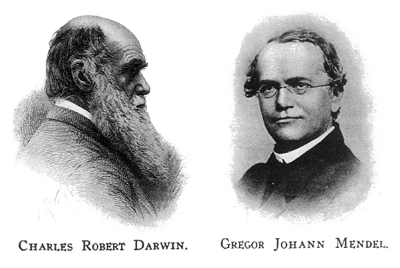 beaks, larger brains,etc.—which gave them an advantage over their fellows. This made them more likely to survive and reproduce until they became the dominant strain. Darwin was unable to explain exactly how these changes took place, he could only observe their results. There was an obvious problem with using appearance as the only method of sorting out the data. It is not uncommon for animals of entirely different lineages to look quite similar—sharks (a type of fish) and dolphins (which are mammals).
beaks, larger brains,etc.—which gave them an advantage over their fellows. This made them more likely to survive and reproduce until they became the dominant strain. Darwin was unable to explain exactly how these changes took place, he could only observe their results. There was an obvious problem with using appearance as the only method of sorting out the data. It is not uncommon for animals of entirely different lineages to look quite similar—sharks (a type of fish) and dolphins (which are mammals). 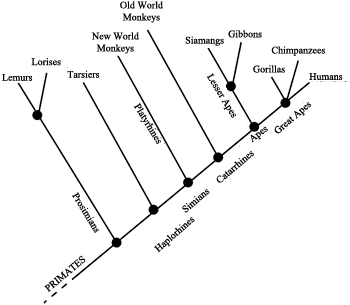 case that fossil remains are found in fragments so that it is often very difficult to determine the exact relationship between two species. Nevertheless it is fair to say that current thinking on the subject of human evolution is largely based on Darwin’s ideas of natural selection and direct observation, and Mendelian genetics. However, reconciling the two methods is problematic in many instances and deciding which has priority is the subject of ongoing debate.
case that fossil remains are found in fragments so that it is often very difficult to determine the exact relationship between two species. Nevertheless it is fair to say that current thinking on the subject of human evolution is largely based on Darwin’s ideas of natural selection and direct observation, and Mendelian genetics. However, reconciling the two methods is problematic in many instances and deciding which has priority is the subject of ongoing debate. 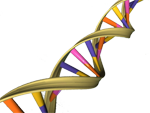
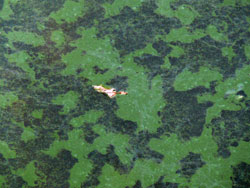 necessary for replication. DNA is essentially a twisted double helix of linked pairs of elements known as nucleotides. It replicates itself by “unzipping” and the nucleotides in the separate strands linking up with new partners. There are single strand nucleic acids known as RNA (ribonucleic acid), which performs a similar function in some viruses. It can be made to reproduce itself in the lab but has not been observed to do so in nature.
necessary for replication. DNA is essentially a twisted double helix of linked pairs of elements known as nucleotides. It replicates itself by “unzipping” and the nucleotides in the separate strands linking up with new partners. There are single strand nucleic acids known as RNA (ribonucleic acid), which performs a similar function in some viruses. It can be made to reproduce itself in the lab but has not been observed to do so in nature.
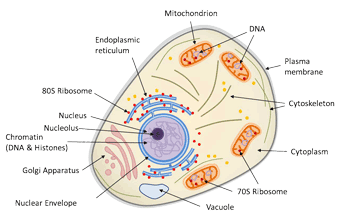
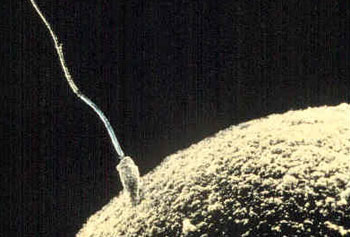 through the consumption and digestion of other organisms. While mobility is a hallmark of animals today, this was not always the case—all of the earliest examples were anchored to the sea bed and had to wait for food to come to them.
through the consumption and digestion of other organisms. While mobility is a hallmark of animals today, this was not always the case—all of the earliest examples were anchored to the sea bed and had to wait for food to come to them. _2.gif)
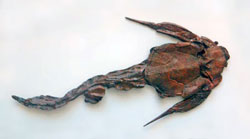
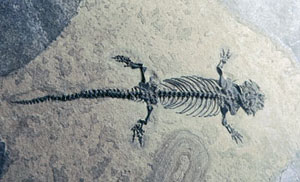 beds of Europe and eastern North American were laid down. These were simple plants (ferns, horsetails, etc.) but some of them grew to heights of 20 metres or more. Levels of atmospheric oxygen rose which encouraged the spread of animal life. Insects, arachnids and myriapods (centipedes, millipedes, etc) appear late in the Carboniferous and they were soon followed by the first land vertebrates, a Superclass known as the Tetrapods (Greek for “four-legged”).
beds of Europe and eastern North American were laid down. These were simple plants (ferns, horsetails, etc.) but some of them grew to heights of 20 metres or more. Levels of atmospheric oxygen rose which encouraged the spread of animal life. Insects, arachnids and myriapods (centipedes, millipedes, etc) appear late in the Carboniferous and they were soon followed by the first land vertebrates, a Superclass known as the Tetrapods (Greek for “four-legged”).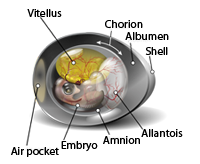
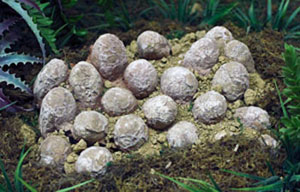 necessities of life—a rudimentary shell. Within it were apparatuses for respiration (allantois) and food supply (yoke). At the heart of the egg was a watery membrane sac known as the amnion, which gives its name to this new “branch” or Clade. The amnion provides a protective environment for the embryo to develop. Because of the shell, the egg had to be fertilized before the shell formed, so male amniotes had to introduce their sperm directly into the body of the female. All living birds and reptiles lay eggs as do a few mammals, such as the platypus—even the embryos of mammals who do not lay eggs contain the same elements. At this point, there was little to set them apart from the reptiles apart from the fact that they had one rather than two openings (temporal fenestrae) in the side of their skulls, behind each eye socket. The photo (left), shows fossilized dinosaur eggs from China.
necessities of life—a rudimentary shell. Within it were apparatuses for respiration (allantois) and food supply (yoke). At the heart of the egg was a watery membrane sac known as the amnion, which gives its name to this new “branch” or Clade. The amnion provides a protective environment for the embryo to develop. Because of the shell, the egg had to be fertilized before the shell formed, so male amniotes had to introduce their sperm directly into the body of the female. All living birds and reptiles lay eggs as do a few mammals, such as the platypus—even the embryos of mammals who do not lay eggs contain the same elements. At this point, there was little to set them apart from the reptiles apart from the fact that they had one rather than two openings (temporal fenestrae) in the side of their skulls, behind each eye socket. The photo (left), shows fossilized dinosaur eggs from China. 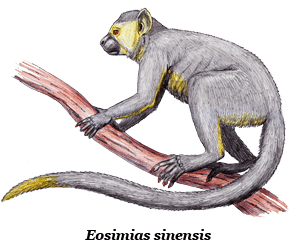
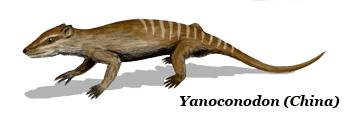
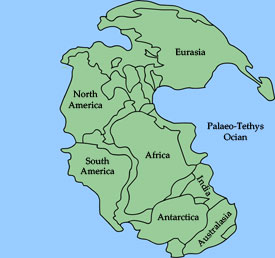
_(5985361456).jpg)
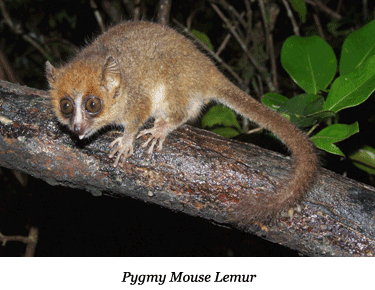 Primates all share much the same protein structure and DNA composition, and they were (initially) very similar in size and appearance. They were on the small side and well-adapted to life in the trees that were their primary habitat—not unlike the Pigmy Mouse Lemurs (right) sometimes spotted in Madagascar today. They would eat just about anything they could find including insects and their larvae, and bird’s eggs along with the seeds, nuts and fruit that was amply available. True omnivores, just like us.
Primates all share much the same protein structure and DNA composition, and they were (initially) very similar in size and appearance. They were on the small side and well-adapted to life in the trees that were their primary habitat—not unlike the Pigmy Mouse Lemurs (right) sometimes spotted in Madagascar today. They would eat just about anything they could find including insects and their larvae, and bird’s eggs along with the seeds, nuts and fruit that was amply available. True omnivores, just like us.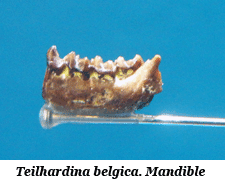
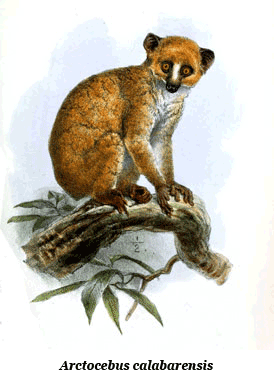
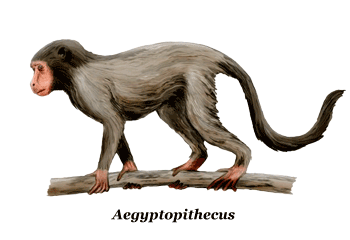
-1.png)
_Tanjung_Puting_National_Park_-_Indonesia_1.png)
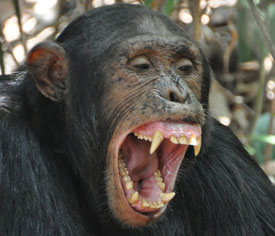 dimorphism to one degree or another, which means that males are larger than females. The gestation period for an infant is about eight or nine months. Even then, the newborns are helpless for a longer time and achieve maturity much later than other species—by as much as a dozen years or more. Apart from us, the living family members are the gorillas (Gorilla) along with the chimpanzees and bonobos (Pan) that are found today in central Africa; and the orangutans (Pongo) and gibbons (Hylobatidae) of southeast Asia.
dimorphism to one degree or another, which means that males are larger than females. The gestation period for an infant is about eight or nine months. Even then, the newborns are helpless for a longer time and achieve maturity much later than other species—by as much as a dozen years or more. Apart from us, the living family members are the gorillas (Gorilla) along with the chimpanzees and bonobos (Pan) that are found today in central Africa; and the orangutans (Pongo) and gibbons (Hylobatidae) of southeast Asia. 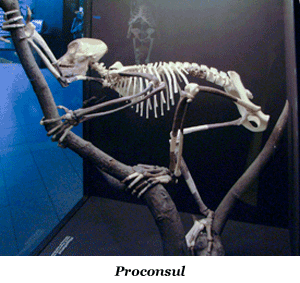
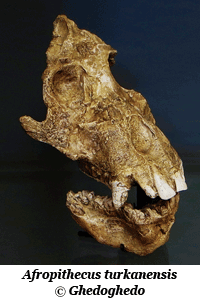
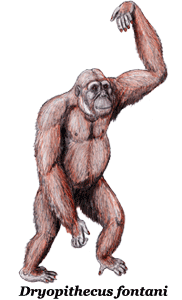 The general consensus among palaeoanthropologists is that the Hominidae included two Subfamilies—the Homininae, which includes all of the African ‘great apes’ including us, and the Ponginae, which includes the various orangutan species of S0utheast Asia. The evidence—molecular-clock analysis—suggests that the split occurred sometime between 14 and 12½ million years ago, during the Middle Miocene.
The general consensus among palaeoanthropologists is that the Hominidae included two Subfamilies—the Homininae, which includes all of the African ‘great apes’ including us, and the Ponginae, which includes the various orangutan species of S0utheast Asia. The evidence—molecular-clock analysis—suggests that the split occurred sometime between 14 and 12½ million years ago, during the Middle Miocene.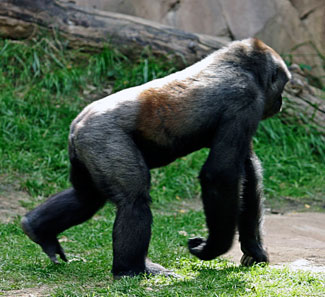
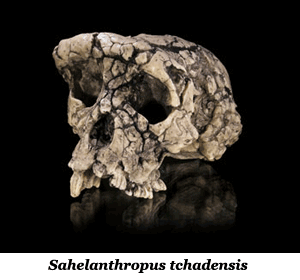
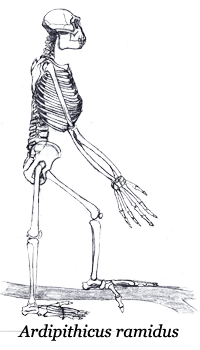
.gif)
_at_Goteborgs_Naturhistoriska_Museum_8564.jpg) landscape.
landscape. _Fundort_Nariokotome,_Kenia,_Rekonstruktion_im_Neanderthal_Museum.gif)
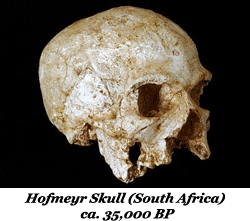 distribution of the fossil remains (both in space and time) and their incomplete nature—a jawbone here, a cranium there—hundreds if not thousands of miles apart, and separated by thousands of years. Do they represent the same species over time or distinct variants? It is the current consensus that our line is descended from H. heidelbergensis, which has a larger brain (c. 1250 cc) but otherwise retains many characteristics typical of H. erectus
distribution of the fossil remains (both in space and time) and their incomplete nature—a jawbone here, a cranium there—hundreds if not thousands of miles apart, and separated by thousands of years. Do they represent the same species over time or distinct variants? It is the current consensus that our line is descended from H. heidelbergensis, which has a larger brain (c. 1250 cc) but otherwise retains many characteristics typical of H. erectus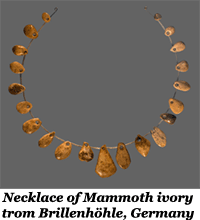 interbreeding between the species.
interbreeding between the species.